“Sherpas working on Everest normally don't die en masse. Apart from their darkest seasons – 1922, 1970, and now, 2014, the darkest of all – they tend to perish one by one, casualties of crevasse falls, avalanches, and altitude sickness. Some have simply disappeared on the mountain, never to be seen again. If mentioned at all, their individual deaths are briefly noted in the Western media. Last year, when the attention of the world was focused on a fight between Sherpas and some Western mountaineers, you would hardly have known four Sherpas died on Everest in separate incidents. Likewise, the year before: three more Sherpa fatalities.
The sad fact is that over the years Sherpas and Nepali mountain workers have died so routinely – 40 percent of all Everest deaths over the last century – that it's easy for Western tourists and guiding agencies, Nepali officials, and even some Sherpas themselves to gloss over the loss of any one particular life. Sincere condolences are offered. Inadequate insurance payments are made. Chortens are built, plaques affixed, pictures posted on blogs. And then all parties turn back to the mighty Everest cash machine and the booming business of catering to thousands of foreigners paying small fortunes to stand on the top of the world”. – Chip Brown via National Geographic
The sad fact is that over the years Sherpas and Nepali mountain workers have died so routinely – 40 percent of all Everest deaths over the last century – that it's easy for Western tourists and guiding agencies, Nepali officials, and even some Sherpas themselves to gloss over the loss of any one particular life. Sincere condolences are offered. Inadequate insurance payments are made. Chortens are built, plaques affixed, pictures posted on blogs. And then all parties turn back to the mighty Everest cash machine and the booming business of catering to thousands of foreigners paying small fortunes to stand on the top of the world”. – Chip Brown via National Geographic
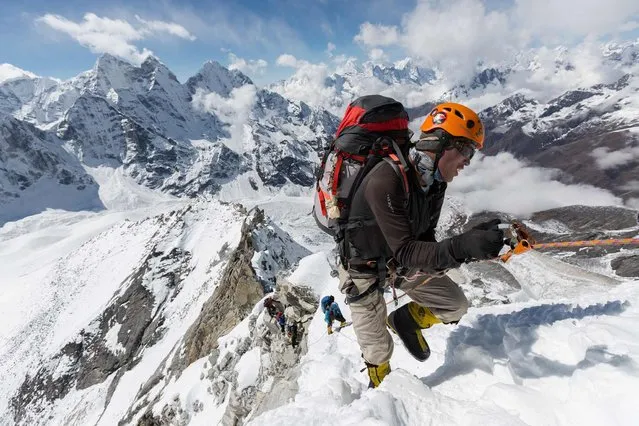
Danuru Sherpa, a veteran guide, pulls his way up a fixed line between Camp 1 and Camp 2 on Ama Dablam. To help climbers reach the top of the beautiful, steep peak, Sherpas attach ropes to the snow and ice for clients hold on to during ascent. (Photo by Aaron Huey/National Geographic)
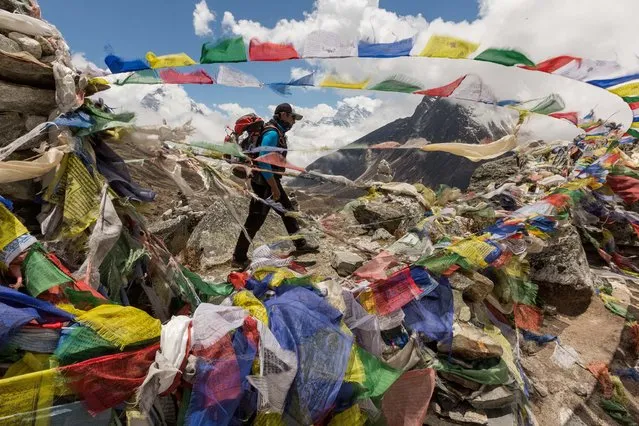
On the trek to Mount Everest, Mingma Ongel Sherpa passes by prayer flags at a memorial for Sherpas who died on the peak. Since the first expeditions in the 1920s, 99 Sherpas and other Nepalis have been killed on Everest – about 40 percent of all climbing deaths there. (Photo by Aaron Huey/National Geographic)
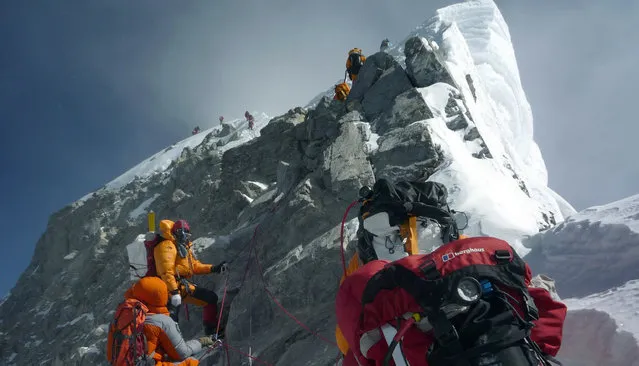
In this May 19, 2009 file photograph, unidentified mountaineers walk past the Hillary Step while pushing for the summit of Mount Everest as they climb the south face from Nepal. A group of top Nepalese climbers is planning a high-risk expedition to clean up Everest, saying decades of mountaineering have taken their toll on the world's highest peak. “Everest is losing her beauty”, seven times Everest summitteer Namgyal Sherpa, 30, told AFP. “The top of the mountain is now littered with oxygen bottles, old prayer flags, ropes, and old tents. At least two dead bodies have been lying there for years now”. (Photo by Courtesy of Pemba Dorje Sherpa/AFP Photo)
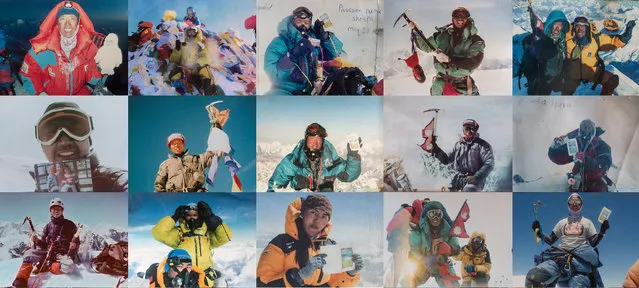
Taking pride in their moments of glory, Sherpa guides pose for snapshots on the summits of Himalayan giants such as Mount Everest (29,035 feet/8,850 meters), Cho Oyu (26,906 feet/8,201 meters), Ama Dablam (22,493 feet/6,812 meters), and Island Peak (20,210 feet/6,160 meters). Clockwise from left: Tenzing Dorjee Sherpa, Sonam Tashi Sherpa, Passang Nuru Sherpa, Phu Tashi Sherpa, Pemba Sherpa and Pensa G Sherpa, Phunuru Sherpa, Tenzing Dorjee Sherpa, Danuru Sherpa, Panuru Sherpa, Pemba Nuru, Sonam Tashi Sherpa, Tenzin Gyaltzen Sherpa, Pasang Lhamu Sherpa, Phu Tashi Sherpa, Panuru Sherpa. (Photo by National Geographic)
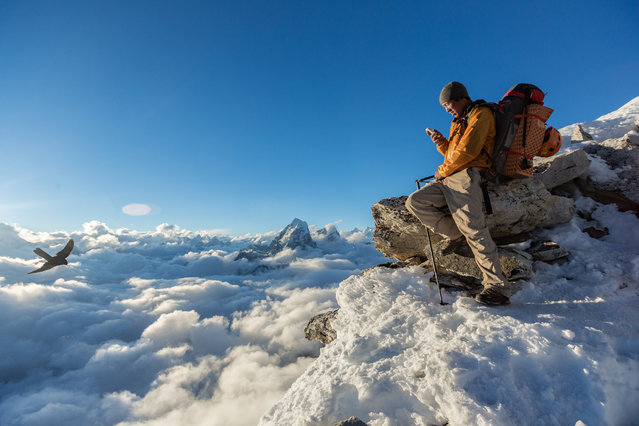
Finding just the right spot above the clouds at Camp 1 on Ama Dablam, Danuru Sherpa uses his iPhone to catch up with friends and family. Even at 18,500 feet (5,654 meters), climbers here can check their email and other dispatches from the world below. (Photo by Aaron Huey/National Geographic)
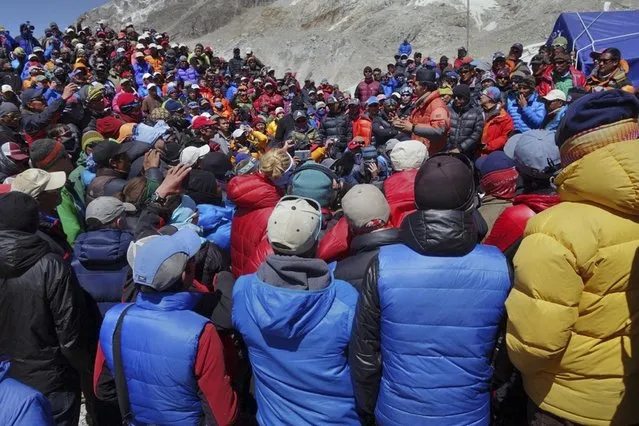
This April 24, 2014 photo released by Adrian Ballinger, founder and head guide of Alpenglow Expeditions, shows a meeting between Nepalese government delegation and Sherpa mountain guides near Everest base camp, Nepal. Nepal's attempts to salvage the Mount Everest climbing season took another hit Friday as more Sherpa mountain guides packed and left the base camp for their village homes a week after the deadliest disaster on the world's highest mountain. (Photo by Adrian Ballinger/AP Photo/Alpenglow Expeditions)
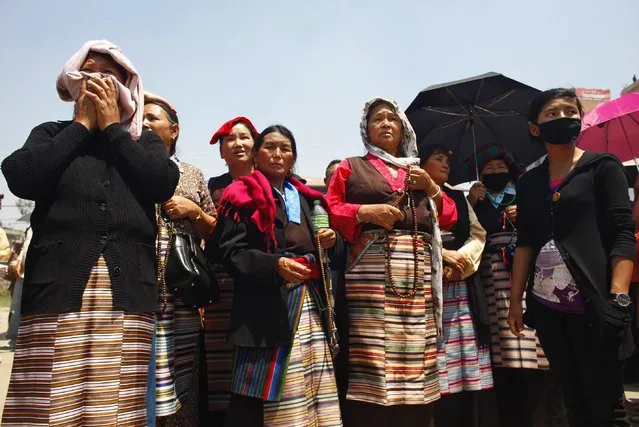
Relatives of Nepalese climbers killed in an avalanche on Mount Everest, wait for the funeral procession to begin in Katmandu, Nepal, Monday, April 21, 2014. Buddhist monks cremated the remains of Sherpa guides who were buried in the deadliest avalanche ever recorded on Mount Everest, a disaster that has prompted calls for a climbing boycott by Nepal's ethnic Sherpa community. The avalanche killed at least 13 Sherpas. Three other Sherpas remain missing and are presumed dead. (Photo by Niranjan Shrestha/AP Photo)
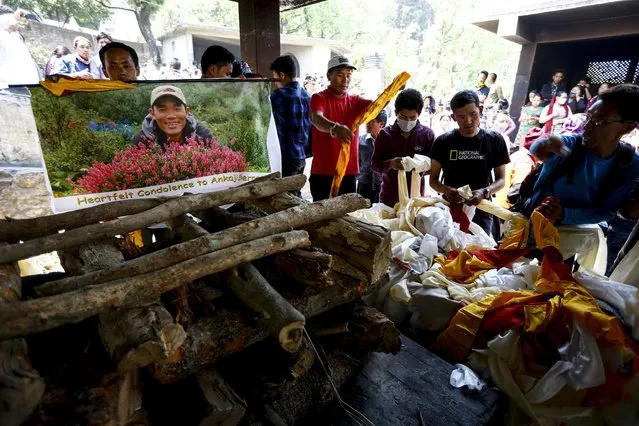
Relatives of Nepalese mountaineer Ang Kaji Sherpa, one of the victims of the Mount Everest avalanche on 18 April, attend the cremation ceremony at Syambhu in Kathmandu, Nepal, 21 April 2014. The single deadliest accident in the history of the world's highest mountain took the lives of 16 Sherpas on 18 April 2014, leaving the Everest climbing community in a state of shock. (Photo by Narendra Shrestha/EPA)
28 Apr 2014 09:14:00,
post received
0 comments
